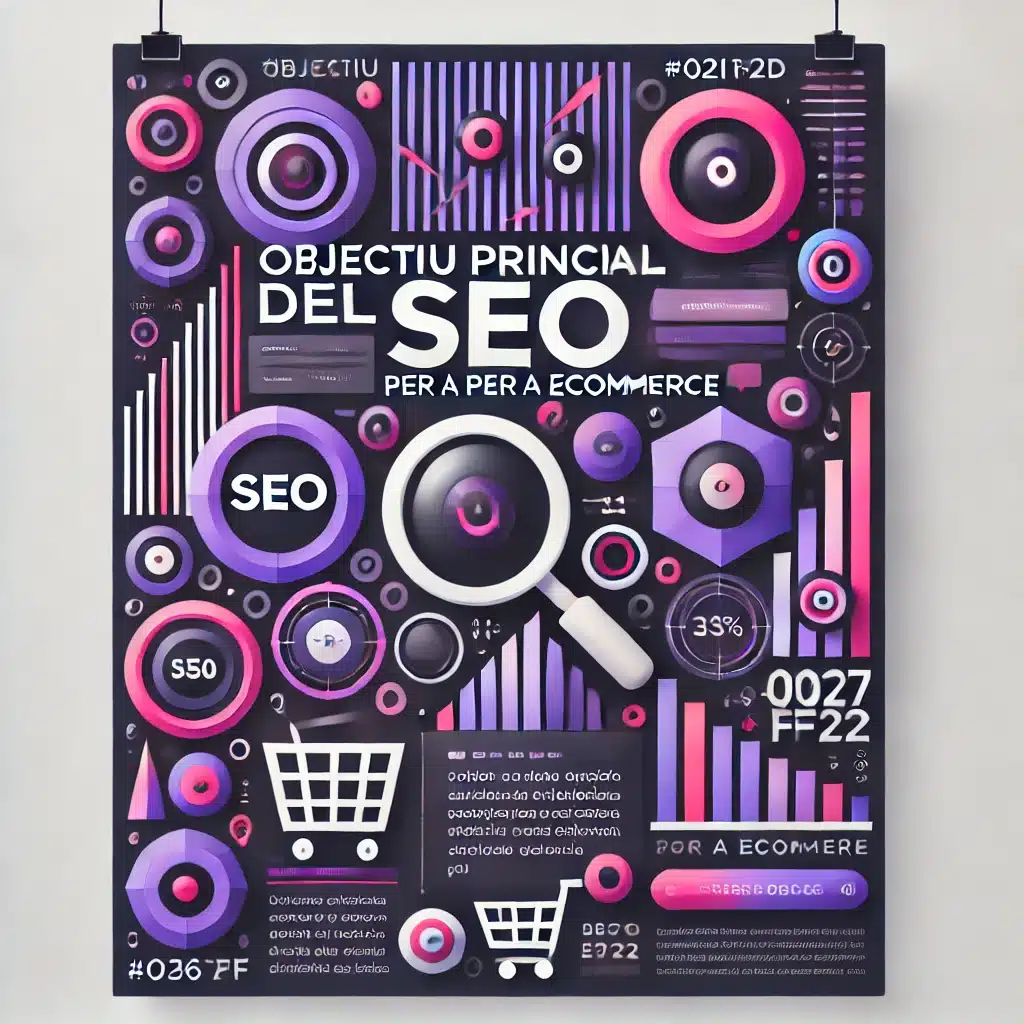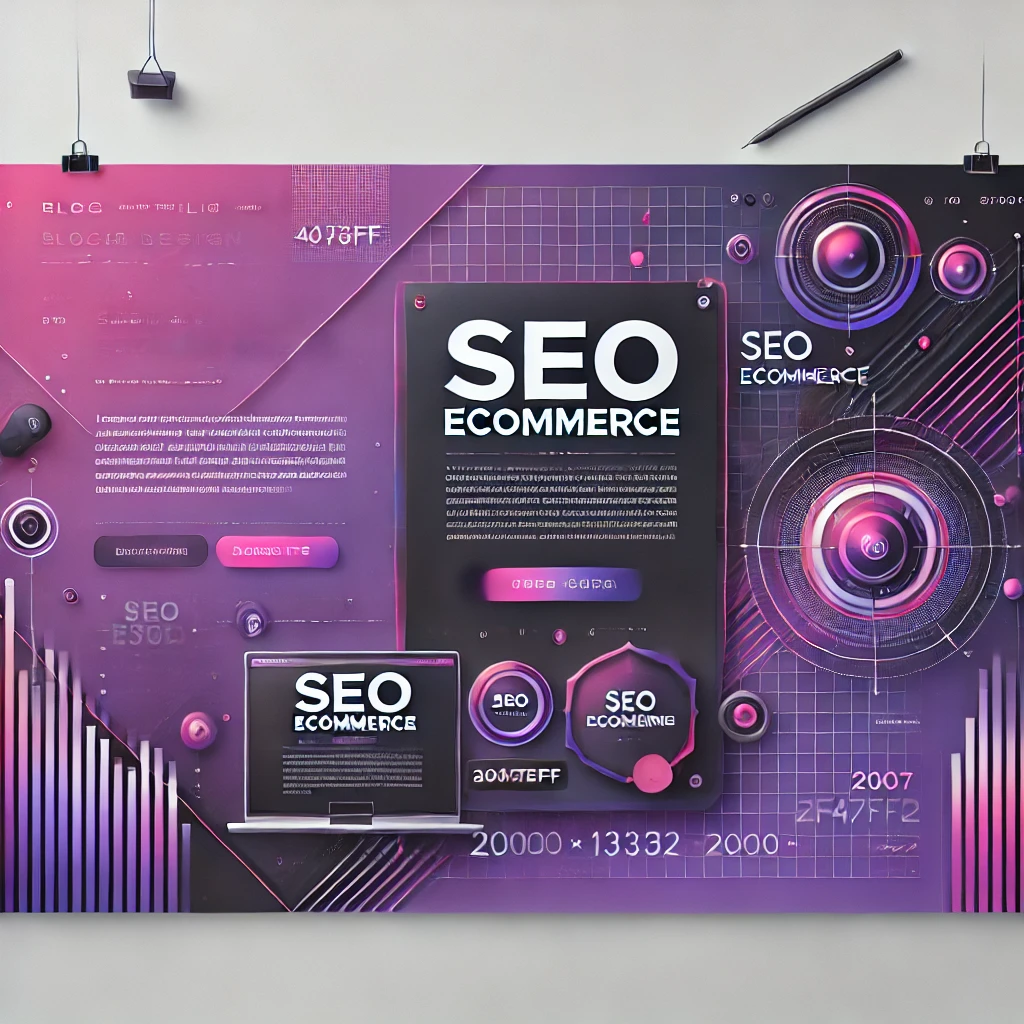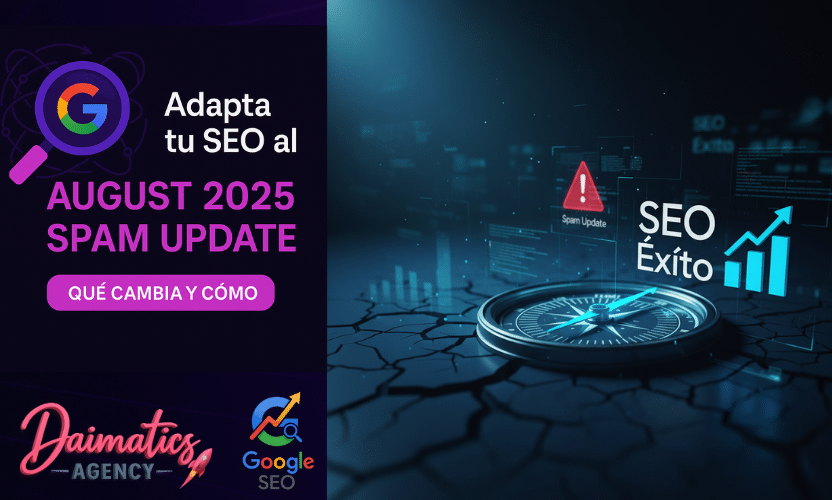Table of Contents
Togglewhat is the seo for eCommerce?
The seo for eCommerce, or Search Engine Optimization for e-commerce, is a set of techniques and strategies designed by improve the visibility of an online store in the organic results of search engines like Google. Unlike the seo traditional, which focuses on educational or corporate content, the seo for eCommerce is totally focused on the specific needs of online stores.
Differences between seo traditional and seo for eCommerce
- Volume of pages: Online stores have hundreds or even thousands of product pages, categories and subcategories. This can generate duplicate content, one of the most frequent problems in the seo for eCommerce.
- URL management: Stores use filters and facets (color, size, price, etc.) that they can generate Unnecessary URLs or duplicates if not properly managed.
- Search intent: While the seo traditional usually attracts informational traffic (eg: "how to make a bread recipe"), the seo for eCommerce works with transactional intentions, like now “buy mountain shoes in Andorra” or “best price for graphics tablets”.
Main objective of the seo for eCommerce
The main objective of the seo for online stores is attract qualified organic traffic and convert it into sales. This is done through a combination of strategies including:
- seo technician: Optimization of the web structure to ensure optimal indexing.
- Relevant content: Creation of original and unique descriptions for each product and category.
- Shopping focused keywords: Use of expressions like “buy”, “best price” or “offer” to attract users with clear purchasing intent.
Practical example
If you have a shop that sells ski equipment, a well-optimized category page can attract users with general searches like “women's ski clothes”, while one optimized product page can capture more specific searches like “waterproof anorak size M for skiing”.
Other key benefits
- Reduction of advertising costs: A strategy seo solid reduces dependence on paid campaigns such as Google Ads.
- Long-term sustainability: The seo it is an investment with a high return on investment (ROI) which continues to bear fruit over time.
- Better user experience: With a clear structure and well-organized data, the website becomes easier to use and navigate.

Why is the seo for online stores?
The seo it is essential for any online store that wants to stand out in a competitive market. Unlike physical stores, a eCommerce is totally dependent on web traffic to get sales. Therefore, a good strategy of seo not only increases visibility, but also contributes to the consumer confidence and the reduction of advertising costs.
Specific benefits of seo for online stores
- Generate qualified organic traffic
- with the seo, you attract users who are looking for exactly what you offer. This means that the visits to your site are from users who are genuinely interested in your products.
- Example: A customer searching for “waterproof trekking boots” will arrive at your page if you have good keyword optimization.
- Reduction of advertising costs
- Unlike the SEM, the seo does not require pay per click. Once the page is optimized, organic traffic can increase at no additional cost.
- This is especially important for stores with tight margins, as they can reallocate these resources to other areas such as logistics or customer service.
- Improvement of ROAS (return on advertising spend)
- The seo complements other strategies such as Google Ads or Facebook Ads. Both can generate traffic in the short term, but the seo ensures a sustainable source of traffic over time.
- Important data: According to studies, organic traffic represents the 53% of total traffic of an average website.
- Increased consumer confidence
- Stores that appear in the top positions of Google are perceived as more reliable and authoritativeThis translates into a better CTR (click-through rate) and, ultimately, more conversions.
- In addition, the presence of rich snippets (opinions, stars, prices) can further improve trust.
Impact of seo in consumer behavior
Today's consumers are more demanding and spend an average of 3 to 5 searches before deciding to buy a product. Therefore, if your eCommerce does not appear in these searches, it is very likely that you will lose sales to the competition.
Relevant statistics: According to a Backlinko study, the first organic result on Google receive the 27.6% of the clicks, while the second only a 15%. This means that being in the first places is essential.
Examples of real cases
- Appliance store
- An online store that optimized product pages with unique descriptions and real customer reviews increased organic traffic by 35% in 6 monthsIn addition, it reduced advertising costs by 20% thanks to less dependence on SEM.
- Fashion eCommerce
- After incorporating structured data to show stock and prices directly in search results, this store saw a increase of 40% in conversions in just three months.
Key strategies to improve positioning seo of an eCommerce
Lorem ipsum dolor sit amet, consectetur adipiscing elit. Ut elit tellus, luctus nec ullamcorper mattis, pulvinar dapibus leo.
Optimizing an eCommerce requires a comprehensive strategy that encompasses the seo technician, the seo on-page and the seo off-pageBelow, we will explore each of these aspects in detail to ensure that your online store achieves the best results.
seo technician: Foundation of optimized eCommerce
- Structure of the URLs
- URLs should be clear, descriptive and search engine friendly.
- Example: Avoid URLs like
www.botiga.com/product123and use insteadwww.botiga.com/sabatilles-running. - Include relevant keywords in URLs to improve positioning.
- Sitemaps and robots.txt
- Generate a XML sitemap to help search engines crawl the most important pages on your site.
- Configure the file robots.txt to prevent Google from indexing irrelevant pages such as filters or internal search results.
- Loading speed optimization
- Users abandon pages that take more than 3 seconds to load.
- Key Actions:
- Compress images and use formats like WebP.
- implement Lazy Loading so that images are only loaded when they are visible.
- Use one CDN (Content Delivery Network) to reduce latency.
- Core Web Vitals
- Focus on the three main factors:
- LCP (Largest Contentful Paint): Main content loading speed.
- FID (First Input Delay): Time it takes for the site to respond to the first interaction.
- CLS (Cumulative Layout Shift): Avoid unexpected movements of the content.
- Focus on the three main factors:
seo On-Page: Optimization of content and keywords
- Category optimization
- Category pages are one of the most valuable assets in an eCommerce store. Optimize them with:
- Unique titles that include main keywords.
- Informative descriptions with secondary keywords.
- Supporting texts that explain the benefits of shopping in your store.
- Category pages are one of the most valuable assets in an eCommerce store. Optimize them with:
- Product pages
- Each product needs:
- one unique description that resolves customer queries and incorporates keywords.
- Structured data to display prices, stock and ratings directly in search results.
- Example: If you sell “waterproof trekking shoes,” mention terms like “comfortable,” “mud-resistant,” and “best price.”
- Each product needs:
- Meta descriptions
- Write engaging meta descriptions with a call to action that invites you to click.
- Example: “Discover the best running shoes on the market with free shipping and exclusive offers. Buy now!”.
seo Off-Page: Building authority
- Link building
- Generate quality links from authority sites that strengthen the positioning of your store.
- Example: Collaborate with bloggers in the sector so they link to your product or category pages.
- Mentions in places of authority
- Participate in relevant forums, publishes guest articles or look for collaborations with influencers to increase your online presence.
- Social media strategies
- Although social networks do not directly affect the seo, can generate traffic to your eCommerce, increasing visibility and brand recognition.
Useful tools to implement these strategies
- Screaming Frog: To identify technical errors such as broken links or duplicate content.
- Google Analytics and Search Console: To measure traffic, CTR and top keywords.
- Ahrefs o SEMrush: To build a linkbuilding strategy and analyze the competition.

Content management and marketing strategies for eCommerce
Evergreen content creation
Evergreen content, which remains relevant over time, is a long-term investment to generate consistent traffic and establish authority.- Guides and tutorials
- Publish articles that solve common customer questions or help them make decisions.
- Example: If you sell home appliances, create a guide titled “How to Choose the Best Washing Machine for Your Home.”
- Product reviews
- Share detailed reviews of your products highlighting their benefits and use cases.
- This not only increases customer confidence but also improves positioning seo thanks to the inclusion of related keywords.
- Dynamic FAQs
- Add FAQ sections to product pages.
- Example: “Are these shoes waterproof?” or “What size is right for me?”.
eCommerce blog optimization
Blogging is a powerful tool for attracting organic traffic and educating your potential customers.- Articles related to your products
- Create content that addresses topics related to the products you sell.
- Example: If you own a furniture store, an article titled “Decoration Trends for 2025” can attract users interested in renovating their space.
- Long tail keywords
- Include specific keywords that reflect specific search intent.
- Example: “The best hiking shoes for long routes.”
- SEO-friendly structure
- Use clear titles and subtitles.
- Add internal links to product or category pages.
- Optimize images with alt texts and descriptive names.
Use of optimized visual content
Visual content is not only attractive, but can also enhance the seo when properly optimized.- Videos
- Publish demo videos, tutorials or reviews of your products.
- Example: “How to assemble your mountain bike in 5 minutes.”
- Add descriptive titles, transcripts, and subtitles to make them accessible and SEO-friendly.
- images
- Quality images are essential in an eCommerce. Optimize them for seo:
- Use descriptive file names (example: “waterproof-hiking-shoes.jpg”).
- Include alternative texts that describe the object and include keywords.
- Quality images are essential in an eCommerce. Optimize them for seo:
- Infographics
- Share complex information in a visual and engaging way.
- Example: An infographic explaining “The benefits of smart washing machines” can be shared on social media, attracting additional traffic.
Collaborations and user-generated content
- Customer reviews
- Encourage customers to leave reviews and ratings. This not only builds trust but also provides unique content for your pages.
- influencers
- Work with influencers to reach new audiences. Their reviews can drive traffic and sales.
- Success stories
- Share testimonials or success stories from your customers.
- Example: A post titled “How Jordi found the perfect shoes for his trip to Iceland.”
Measure the impact of your content
Use tools like Google Analytics to evaluate which pages or types of content generate the most traffic and conversions.- CTR: Compare the click-through rate of articles with product pages.
- Stay time: Are users spending enough time on your site reading your content?
- Conversion rate: What percentage of blog visitors end up buying?
Mobile and local search optimization
Importance of responsive design
A website that doesn't display properly on mobile can lose potential customers and negatively affect your seo. Google prioritizes websites that offer a good user experience on mobile devices.- What is responsive design?
- It is a design approach that adjusts the structure and content of the website according to the screen size.
- Example: Buy buttons should be large and easy to click on small screens.
- Advantages of responsive design:
- Better user experience, which translates into more conversions.
- Reduction in the bounce rate, since users do not abandon due to navigation problems.
- Higher positioning in mobile searches thanks to Google's Mobile-First Index algorithm.
Loading speed on mobile devices
Loading speed is especially critical on mobile, where users expect the page to load in less than 3 seconds.- Strategies to improve speed:
- Image compression: It uses formats like WebP that reduce the size without losing quality.
- Lazy Loading: Allows images to load only when the user moves them into their field of view.
- AMP (Accelerated Mobile Pages): A Google technology that creates ultra-light versions of your pages for mobile searches.
- Recommended tool:
- use PageSpeed Insights to analyze and optimize your website speed. This tool provides mobile-specific suggestions.
How to optimize an eCommerce for local searches
Local searches are essential for eCommerce businesses with physical stores or that serve specific areas. Phrases like “near me” or “in Andorra” are widely used by users.- Google Business Profile (formerly Google My Business):
- Register your business and complete key information such as address, telephone number, hours and website link.
- Example: If you have a sporting goods store in Andorra, make sure you appear when someone searches for “hiking equipment store in Andorra.”
- Local keyword optimization:
- Incorporate geographic terms into your website content.
- Example: “The best mountain shoes in Andorra”.
- Reviews and Ratings:
- Positive reviews improve local visibility and build trust.
- Encourage customers to leave reviews on your Google profile.
- Geolocation on the website:
- Use structured data to indicate the exact location of your business.
- Include an interactive map on your contact page.
Benefits of combining seo mobile and local
- Attract quality traffic:
- Local searches are highly intentional. Users often search for products or services with the intention of purchasing soon.
- Increase sales in physical stores:
- According to studies, 781% of local mobile searches result in an offline purchase.
- Differentiate yourself from the competition:
- Many eCommerce businesses still don't have a robust strategy for mobile and local search. Optimizing these aspects can give you a competitive advantage.
Practical examples
- A sportswear store can use the phrase “Mountain clothing in Andorra” on its homepage and in meta descriptions.
- A restaurant can sign up for Google Business and include photos of their dishes and customer reviews.
seo technician for online stores
Structured data setup for products
- What is structured data?
- These are snippets of code that help search engines better understand the content of a website.
- Example: Show prices, available stock and ratings directly on the results pages (rich snippets).
- Recommended structured data types for eCommerce:
- Product: To describe the product's characteristics (price, name, description).
- Reviews: To include user ratings and reviews.
- Offer: To show special offers or discounts.
- Main benefits:
- Improves product visibility in search results.
- Increase your click-through rate (CTR) thanks to additional information.
- Tools to implement structured data:
- Google Structured Data Markup Helper: It makes code creation easier.
- Google Test Rich Results: Verify if the data is being implemented correctly.
Facet and filter management to avoid duplicate content
Many eCommerce sites offer filtering options to improve the user experience (color, size, price, etc.). If not managed properly, they can create multiple versions of the same page, generating duplicate content.- Strategies to avoid duplicates:
- Label noindex: Mark those filter pages that do not add value seo so that they are not indexed by Google.
- Canonical tags: Indicates which is the main URL when multiple pages display similar content.
- Block irrelevant filters with robots.txt: Prevents search engines from crawling unnecessary combinations.
- Practical example:
- If a shoe store has color and size filters, it is necessary to prevent each combination (e.g. “Blue shoes size 40”) from creating an indexable page.
How to control keyword cannibalization within the catalog
Keyword cannibalization occurs when several pages on the same site compete to rank for the same keyword, diluting its authority.- Identify cannibalization:
- Use tools like Google Search Console or SEMRush to detect which pages are competing for the same keywords.
- Solutions to avoid it:
- Consolidate similar content into a single, more complete page.
- Differentiate target keywords for each page.
- Use internal links to reinforce the main page.
- Example:
- If two store pages sell similar mobile phone models, one could position itself for “cheap Android phones” and the other for “best Android phones”.
Crawl optimization with an XML sitemap and robots.txt
- Sitemap XML:
- A map listing all important store URLs.
- Benefit: Helps search engines find and index pages quickly.
- Robots.txt:
- A file that indicates which parts of the site should not be crawled.
- Example: Exclude user account pages or shopping carts.
Loading Speed and Core Web Vitals
Core Web Vitals are metrics that measure user experience in aspects such as speed, interactivity and visual stability.- Key improvements for Core Web Vitals:
- Largest Contentful Paint (LCP): Make sure your main content loads in less than 2.5 seconds.
- First Input Delay (FID): Reduce the response time of interactions (clicks, forms).
- Cumulative Layout Shift (CLS): Avoid unexpected design movements while loading.
- How to improve them?
- Reduce the size of images and videos.
- It uses content delivery networks (CDNs).
- Minify CSS and JavaScript files.
Practical examples of seo technician
- Problem: An appliance store with poorly configured filters generates 1,000 duplicate URLs.
- Solution: Implement canonical tags to prioritize the main page.
- Problem: A trendy website takes 5 seconds to load.
- Solution: Compress images and enable lazy loading.
Trends of seo for eCommerce in 2025
The seo is constantly evolving, and online stores must adapt to new trends to stay competitive. In 2025, several technological innovations and changes in user behavior will mark the future of the seo for eCommerce.
Core Web Vitals and User Experience
- What are Core Web Vitals?
- These are key metrics that Google uses to measure the user experience on a website, including:
- Charging speed: Measures how long it takes for the main content to appear.
- Interactivity: Time it takes for the site to respond to user actions.
- Visual stability: Avoid sudden movements that disrupt navigation.
- These are key metrics that Google uses to measure the user experience on a website, including:
- Impact on eCommerce:
- Sites that prioritize a smooth user experience will rank higher on Google.
- Stores with slow loading times could lose organic traffic and conversions.
- Tip:
- Invest in technical optimization with tools like PageSpeed Insights or Lighthouse.
Artificial intelligence and content personalization
- How is it changing seo with AI?
- Artificial intelligence allows search engines to better understand user intentions.
- Algorithms like BERT i MUM they help Google analyze more complex contexts.
- Applications for eCommerce:
- Personalized recommendations: It uses AI to suggest products based on user behavior.
- Intelligent chatbots: Answers frequent queries and guides customers through the purchasing process.
- Practical example:
- A fashion store can use AI to display complete outfits based on customer preferences.
- Tip:
- Use tools like ChatGPT or Dynamic Yield to implement smart customizations.
Increase in voice searches
- Growing trend:
- With the expansion of assistants like Alexa, Siri, and Google Assistant, voice searches will represent a significant portion of web traffic.
- How to adapt your eCommerce?
- Optimize for conversational keywords: Instead of “buy cheap shoes,” use “Where can I buy cheap shoes near me?”.
- Create short, to-the-point answers: Voice assistants tend to prefer concise and direct content.
- Practical example:
- An appliance store can optimize for searches like “What is the best refrigerator of 2025?”
- Tip:
- Generate content optimized for featured snippets, as they tend to be the preferred response by voice assistants.
News in structured data for eCommerce
- New structured data types:
- Virtual Product: For stores that sell digital products such as software or courses.
- Subscription: For services with recurring subscriptions.
- Impact on seo:
- They help show more details in search results, increasing click-through rates.
- Practical example:
- A coffee subscription store can use structured data to display exclusive offers.
seo for sustainability and social values
- Growing trend:
- Users increasingly value companies that promote sustainability and ethics.
- How to adapt?
- Create content that reflects brand values: Like articles about the sustainable origin of your products.
- Optimize for sustainability-related searches: For example, “eco-friendly clothing” or “shoes made with recycled materials”.
- Practical example:
- A vegan cosmetics store can highlight the positive ecological impact of its products.
Key metrics to analyze the success of a strategy seo for eCommerce
Essential metrics for seo in eCommerce
- CTR (Click-Through Rate):
- What is it?
- Percentage of users who click on your link after seeing it in search results.
- How to improve it?
- Optimize titles and meta descriptions with attractive calls to action and relevant keywords.
- Practical example:
- A headline like “Buy the best running shoes – Free shipping!” can significantly increase CTR.
- What is it?
- Organic conversion:
- What is it?
- Percentage of organic visits that convert into valuable actions, such as purchases or registrations.
- How to improve it?
- It offers relevant content, optimized product pages, and a simple shopping experience.
- Practical example:
- Adding customer reviews or guarantees to product pages can increase trust and conversions.
- What is it?
- Time on page:
- What is it?
- Average time that users spend on each page of your eCommerce.
- How to improve it?
- It provides quality content, detailed product descriptions and attractive visuals.
- Practical example:
- A fashion store might include videos that show how the pieces look on models.
- What is it?
- Bounce Rate:
- What is it?
- Percentage of users who leave the site without interacting with it.
- How to improve it?
- Improve loading speed, reduce intrusive pop-ups, and ensure content is relevant.
- Practical example:
- A gadget store can use clear categories so that users can easily find what they are looking for.
- What is it?
- Keywords positioned:
- What is it?
- Number of keywords for which your eCommerce appears in search results.
- How to improve them?
- Create optimized content and diversify the keywords used.
- Practical example:
- A furniture store can write articles like “Guide to choosing the perfect sofa” to position itself in more relevant terms.
- What is it?
Tools to analyze metrics seo
- Google Analytics:
- It allows you to measure organic traffic, user behavior and conversions.
- Example: Identify which product pages generate the most sales.
- Google Search Console:
- Shows keywords that generate traffic and technical issues.
- Example: Detect URLs that are not indexed correctly.
- Screaming Frog:
- Crawl your site to identify technical errors and improve it seo technician.
- Example: Detect duplicate content or broken links.
- SEMrush and Ahrefs:
- They analyze competitors, keywords and linkbuilding strategies.
- Example: Identify backlink opportunities to strengthen your domain authority.
Importance of A/B testing
- What are A/B tests?
- Experimenting between two versions of a page or element to determine which works best.
- How to use them in eCommerce?
- Example 1: Test two versions of product descriptions to see which one converts better.
- Example 2: Experiment with different calls to action (CTAs) like “Buy Now” vs. “Add to Cart.”
- Benefits:
- Improvements based on concrete data.
- Continuous optimization of the strategy seo.

Common mistakes to avoid in seo for eCommerce
1. Indexing of irrelevant pages
- What does it mean?
- Indexing pages that do not provide value, such as filter results, pages with URL parameters, or duplicate content.
- Why is it problematic?
- It can confuse search engines and dilute the authority of your important pages.
- How to avoid it?
- Implement tags
noindexon unnecessary pages (e.g. product filters). - Use a file
robots.txtto block crawling of unnecessary sections.
- Implement tags
2. Duplicate content
- What does it mean?
- Reusing product descriptions from suppliers or duplicating content between categories and pages.
- Why is it problematic?
- Google penalizes duplicate content, negatively impacting yours seo.
- How to avoid it?
- Write unique product descriptions.
- Use tags
rel=canonicalto indicate the original URL of duplicate content.
- Practical example:
- Instead of using the same description for different shoe models, personalize the content by highlighting specific features.
3. Keyword cannibalization
- What does it mean?
- Multiple pages competing for the same keywords, such as multiple URLs optimized for the same search.
- Why is it problematic?
- Pages "steal" each other's positioning, harming overall results.
- How to avoid it?
- Audit your keywords with tools like Ahrefs or SEMrush.
- Unify similar content into a single optimized page.
4. Bad structure of categories and products
- What does it mean?
- Confusing navigation that makes it difficult to find products and affects search engine crawling.
- Why is it problematic?
- A chaotic structure can cause search engines to not understand the relationships between categories, harming the seo.
- How to avoid it?
- Organize categories logically, with short and descriptive URLs.
- Ex.:
domini.com/roba/t-shirtsinstead ofdomain.com/productid=12345.
5. Insufficient image optimization
- What does it mean?
- Large, unoptimized images that reduce loading speed.
- Why is it problematic?
- Slow loading negatively affects user experience and positioning.
- How to avoid it?
- Compress images with formats like WebP.
- Add descriptive alt tags with keywords.
6. Ignore the seo mobile
- What does it mean?
- Not ensuring that the store is optimized for mobile devices.
- Why is it problematic?
- Google prioritizes the mobile version of sites in its rankings.
- How to avoid it?
- Make sure your site is responsive and loads quickly on mobile devices.
7. Not monitoring technical errors
- What does it mean?
- Not checking for errors like broken links, incorrect redirects, or indexing issues.
- Why is it problematic?
- It can negatively affect the crawlability and trust of the site in search engines.
- How to avoid it?
- Use tools like Screaming Frog to identify errors and correct them regularly.
8. Ignore structured data
- What does it mean?
- Do not implement rich snippets such as prices, availability or reviews.
- Why is it problematic?
- Pages may lose visibility in search results.
- How to avoid it?
- Add structured data for products using the format
JSON-LD.
- Add structured data for products using the format
Final recommendation
Avoiding these mistakes not only protects your ranking, but also ensures a better user experience and effective resource optimization seo.Recommended resources
Explore expert guides
If you found this guide useful, you can delve deeper into specific topics with more specific resources. Below, we highlight some of the guides we recommend:- seo for WooCommerce: Discover how to optimize a store created with Woocommerce, including techniques for improving speed and managing categories.
- seo for Prestashop: Explore best practices for online stores built with Prestashop. Ideal if you are looking for a best agency Prestashop to advise you.
- trends seo 2025: Keep up with the latest trends in the seo and discover how artificial intelligence is changing the landscape.
Resources for your online store
In addition to learning strategies seo, consider these tools and tips to grow your eCommerce:- Choose the right platform
- If you don't have an online store yet or want to switch platforms, check out our guide on the best one. eCommerce platform to maximize performance.
- Featured recommendation: Optimized ecommerce for businesses that want to compete in the first Google results.
- Analyze metrics
- Learn to use tools like Google Analytics, Google Search Console and Screaming Frog to analyze the performance of your website.
- Case study: Monitor your CTR (Click-Through Rate) to optimize the most effective titles and meta descriptions.
- Advanced structured data
- See guides for implementing eCommerce-specific structured data such as
product,reviewiavailability. - Benefit: Increases click-through rate with rich snippets attractive in search results.
- See guides for implementing eCommerce-specific structured data such as
-
Why trust a specialized agency?
Although this guide can help you lay the groundwork for the seo for eCommerce, in many cases, collaborating with experts is the best option to achieve real and sustained results.- Contact experts:A Daimatics, we offer customized solutions for each project. Whether you need help with the seo technician, content creation or Google Ads management, we are here to guide you.
- Check out more details about our service positioning seo.
- Contact experts:A Daimatics, we offer customized solutions for each project. Whether you need help with the seo technician, content creation or Google Ads management, we are here to guide you.







